Page 274 of 395
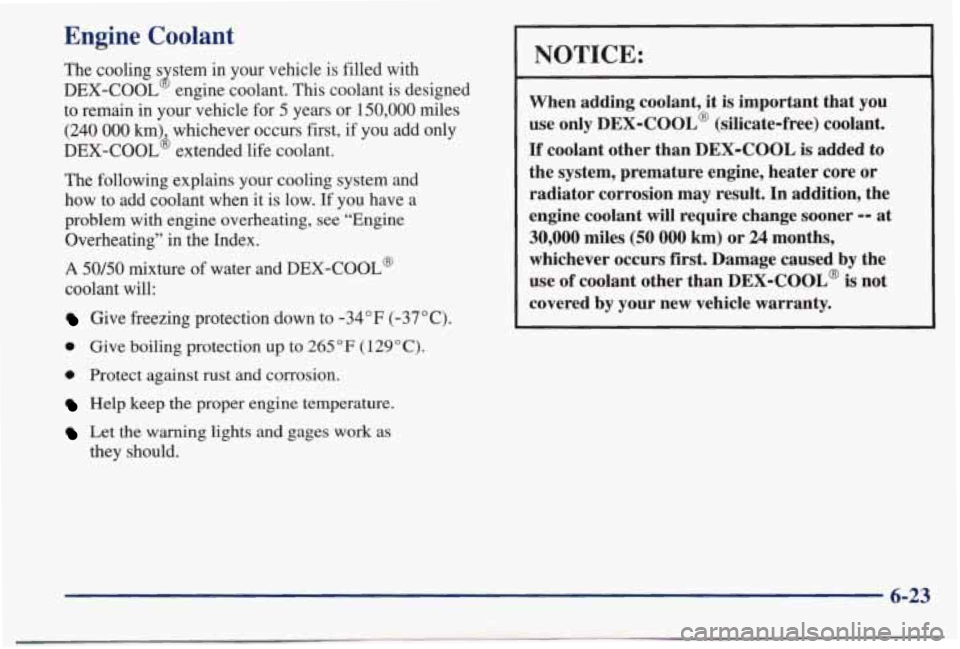
Engine Coolant
The cooling s stem in your vehicle is filled with
DEX-COOL
8 engine coolant. This coolant is designed
to remain in your vehicle for
5 years or 150,000 miles
(240 000 km) whichever occurs first, if you add only
DEX-COOL’ extended life coolant.
The following explains your cooling system and
how to add coolant when it is low. If you have a
problem with engine overheating,
see “Engine
Overheating”
in the Index.
A 50/50 mixture of water and DEX-COOL@
coolant will:
Give freezing protection down to -34°F (-37°C).
0 Give boiling protection up to 265 “F (129°C).
0 Protect against rust and corrosion.
Help keep the proper engine temperature.
Let the warning lights and gages work as
they should.
NOTICE:
When adding coolant, it is important that you
use only DEX-COOL@ (silicate-free) coolant.
If coolant other than DEX-COOL is added to
the system, premature engine, heater core or
radiator corrosion may result. In addition, the
engine coolant
will require change sooner -- at
30,000 miles (50 000 km) or 24 months,
whichever occurs first. Damage caused by the
use of coolant other than DEX-COOL@
is not
covered by your new vehicle warranty.
6-23
Page 275 of 395
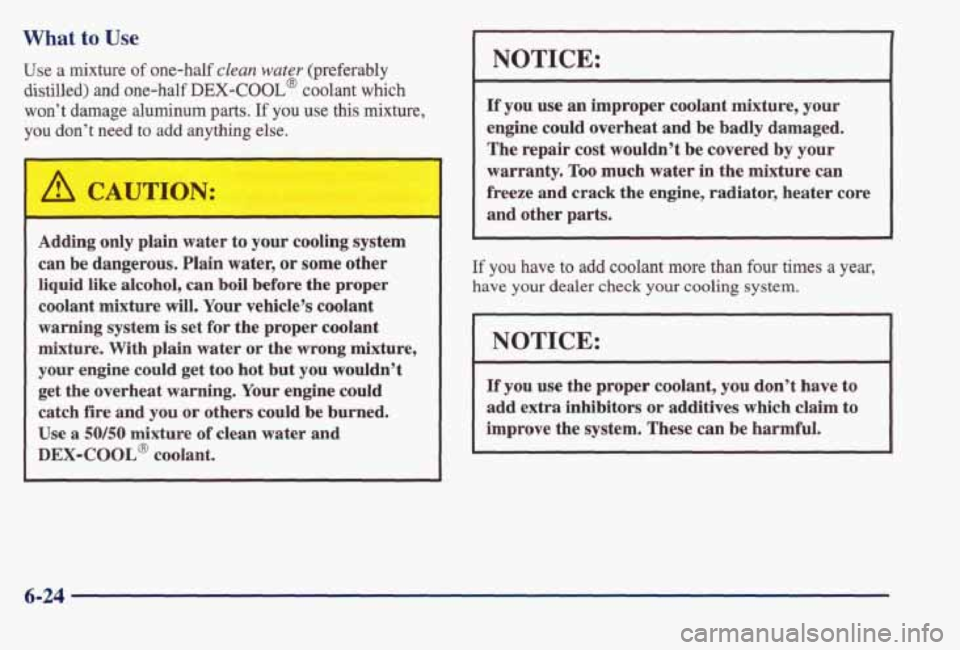
What to Use
Use a mixture of one-half clean water (preferably
distilled) and one-half DEX-COOL@ coolant which
won’t
damage aluminum parts. If you use this mixture,
you
don’t need to add anything else.
Adding only plain water to your cooling system
can be dangerous. Plain water, or some other
liquid
like alcohol, can boil before the proper
coolant mixture will. Your vehicle’s coolant
warning system
is set for the proper coolant
mixture. With plain water or the wrong mixture,
your engine could get too hot but you wouldn’t
get the overheat warning. Your engine could
catch fire and
you or others could be burned.
Use
a 50/50 mixture of clean water and
DEX-COOL@ coolant.
NOTICE:
If you use an improper coolant mixture, your
engine could overheat and be badly damaged.
The repair cost wouldn’t be covered by your
warranty. Too much water in the mixture can
freeze and crack the engine, radiator, heater core
and other parts.
If you have to add coolant more than four times a year,
have your dealer check your cooling system.
I NOTICE:
If you use the proper coolant, you don’t have to
add extra inhibitors or additives which claim to
improve the system. These can be harmful.
6-24
Page 276 of 395
Checking Coolant
When your engine is cold, the coolant level should be at
the
FULL COLD mark or a little higher. When your
engine is
warm, the level should be up to the FULL
HOT mark or a little higher.
LOW
COOLANT
- If this light comes on, it
means you’re
low on
engine coolant.
Adding Coolant
If you need more coolant, add the proper DEX-COOL@
coolant mixture ut the coolant recovery tank, but be
careful not to spill it.
~~~ ~~
lbrning the radiator pressure cap when the
engine and radiator are hot can allow steam
and scalding liquids to blow out and burn
you
badly. With the coolant recovery tank, you will
almost never have to add coolant at the radiator.
Never turn the radiator pressure cap
-- even a
little
-- when the engine and radiator are hot.
6-25
Page 277 of 395
Thermostat
Engine coolant temperature is controlled by a thermostat
in the engine coolant system. The thermostat stops the
You can be burned if you spill coolant on hot
engine parts. Coolant contains ethylene glycol, and it will burn if the engine parts
are hot
enough. Don’t spill coolant on a
hot engine.
Radiator Pressure Cap
ICE:
~~~
Your radiator cap is a 15 psi (105 Wa)
pressure-type cap and must be tightly installed to
prevent coolant loss and possible engine damage
from overheating. Be sure the arrows on the cap
line up with the overflow tube on the radiator
filler neck.
flow of coolant through the radiator until the coolant
reaches a preset temperature.
Power Steering Fluid
The power steering fluid reservoir is located on the rear
passenger side
of the engine compartment.
6-26
Page 278 of 395
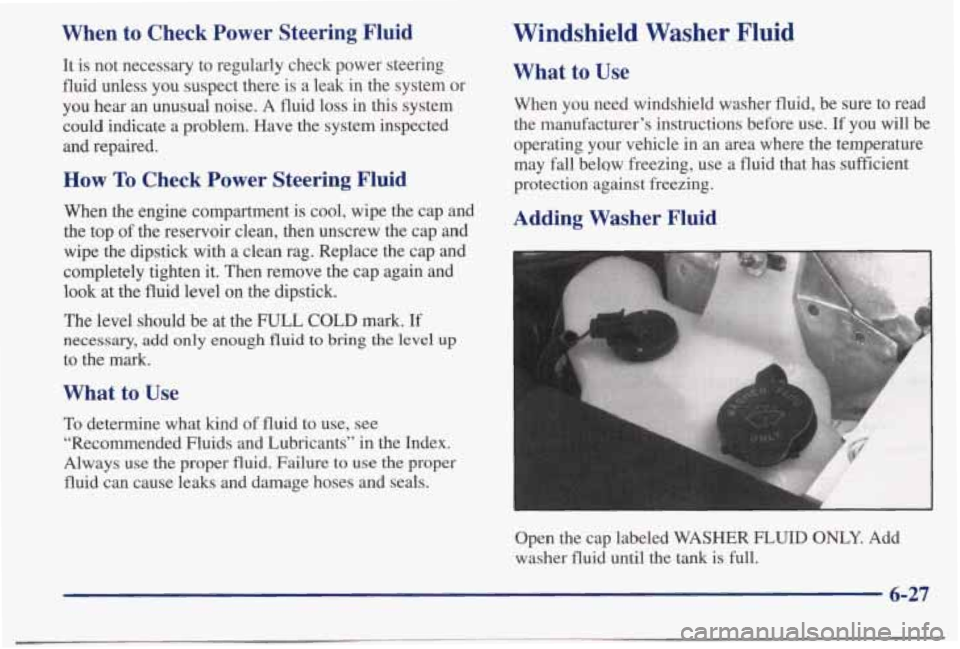
When to Check Power Steering Fluid
It is not necessary to regularly check power steering
fluid unless you suspect there is a leak in the system or
you hear an unusual noise. A fluid loss in this system
could indicate a problem. Have the system inspected
and repaired.
How To Check Power Steering Fluid
When the engine compartment is cool, wipe the cap and
the top
of the reservoir clean, then unscrew the cap and
wipe the dipstick with a clean rag. Replace the cap and
completely tighten it. Then remove the cap again and
look at the fluid level on the dipstick.
The level should be at the
FULL COLD mark. If
necessary, add only enough fluid to bring the level up
to the mark.
What to Use
Windshield Washer Fluid
What to Use
When you need windshield washer fluid, be sure to read
the manufacturer’s instructions before use.
If you will be
operating your vehicle in an area where the temperature
may fall below freezing, use a fluid that has sufficient
protection against freezing.
Adding Washer Fluid
To determine what kind of fluid to use, see
“Recommended Fluids and Lubricants” in the Index.
Always use the proper fluid. Failure to use the proper
fluid can cause leaks and damage hoses and seals.
Open the cap labeled WASHER
FLUID ONLY. Add
washer fluid
until the tank is full.
6-27
Page 279 of 395
NOTICE:
0
0
0
0
When using concentrated washer fluid,
follow the manufacturer’s instructions for
adding water.
Don’t
mix water with ready-to-use washer
fluid. Water can cause the solution to freeze
and damage
your washer fluid tank and
other
parts of the washer system. Also,
water doesn’t clean as well as washer fluid.
Fill your
washer fluid tank only
three-quarters full when it’s
very cold. This
allows for expansion if freezing occurs,
which could damage the tank
if it is
completely full.
Don’t use engine coolant (antifreeze) in
your windshield
washer. It can damage
your washer system and paint.
Brakes
Brake Fluid
Your brake master cylinder reservoir is here. It is filled
with
DOT-3 brake fluid.
6-28
Page 280 of 395
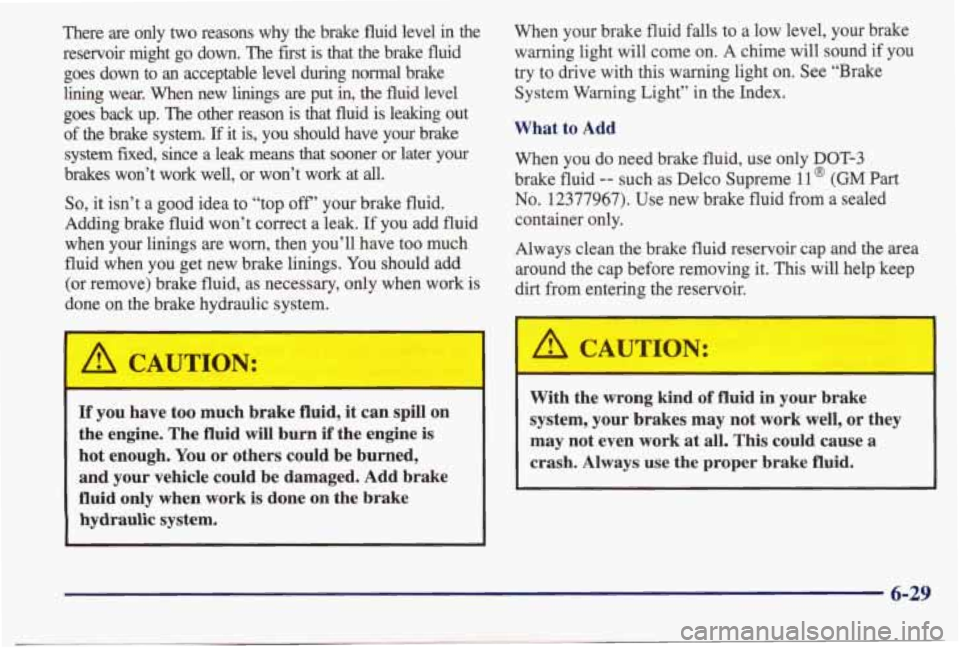
There are only two reasons why the brake fluid level in the
reservoir might go down. The first is that the brake fluid
goes down to
an acceptable level during normal brake
lining wear. When new linings are put in, the fluid level
goes back up. The other reason is that fluid is leaking out
of the brake system.
If it is, you should have your brake
system fixed, since a leak means that sooner or later your
brakes won’t work well, or won’t work at
all.
So, it isn’t a good idea to “top off’ your brake fluid.
Adding brake fluid won’t correct a leak.
If you add fluid
when your linings
are worn, then you’ll have too much
fluid when you get new brake linings. You should add
(or remove) brake fluid, as necessary, only when work
is
done on the brake hydraulic system.
I A CAUTION:
When your brake fluid falls to a low level, your brake
warning light will come on.
A chime will sound if you
try to drive with this warning light on. See “Brake
System
Warning Light” in the Index.
What to Add
When you do need brake fluid, use only DOT-3
brake fluid -- such as Delco Supreme 11 @ (GM Part
No. 12377967). Use new brake fluid from a sealed
container only.
Always clean the brake fluid reservoir cap and the area
around the cap before removing it.
This will help keep
dirt from entering the reservoir.
If you have too much brake fluid, it can spill on
the engine. The fluid will burn if the engine
is
hot enough. You or others could be burned,
and your vehicle could be damaged. Add brake
fluid only when work is done on the brake
hydraulic system.
I b, CAUTION:
With the wrong kind of fluid in your brake
system, your brakes may not work well, or they
may not even work
at all. This could cause a
crash. Always use the proper brake fluid.
6-29
Page 281 of 395
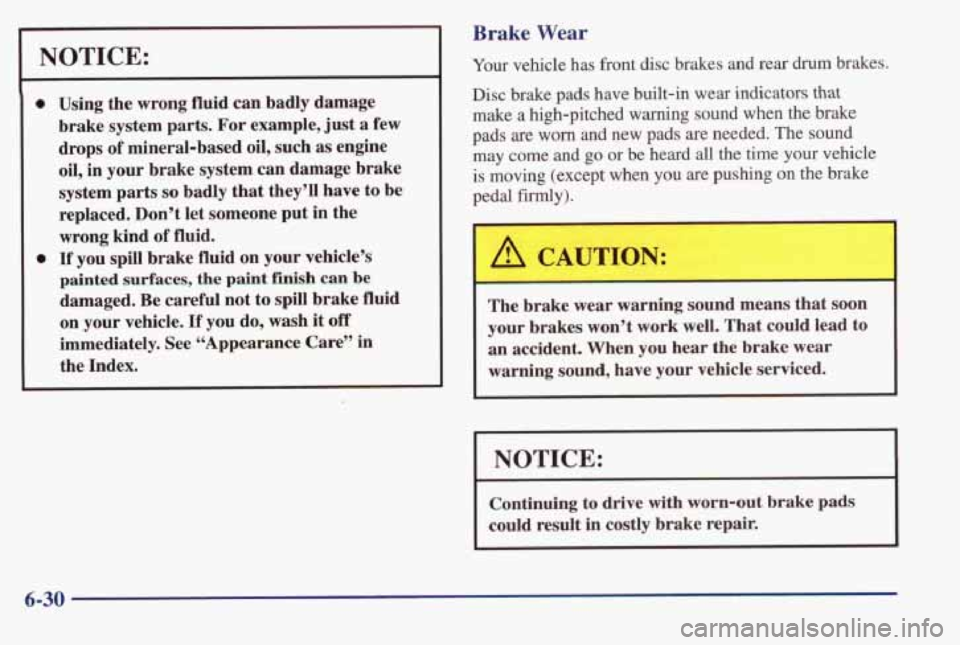
-
NOTICE:
0
0
Using the wrong fluid can badly damage
brake system parts. For example, just a few
drops
of mineral-based oil, such as engine
oil, in your brake system can damage brake
system parts
so badly that they’ll have to be
replaced. Don’t let someone put in the
wrong kind
of fluid.
If you spill brake fluid on your vehicle’s
painted surfaces, the paint finish can be
damaged. Be careful not to spill brake fluid
on your vehicle. If you do, wash it off
immediately. See “Appearance Care” in
the Index.
Brake Wear
Your vehicle has front disc brakes and rear drum brakes.
Disc brake pads have built-in wear indicators
that
make a high-pitched warning sound when the brake
pads are worn and new pads are needed. The sound
may come
and go or be heard all the time your vehicle
is moving (except when
you are pushing on the brake
pedal
firmly).
A 3
,A CAUTION:
I I
The brake wear warning sound means that soon
your brakes won’t work well. That could lead to
an accident. When you hear the brake wear
warning sound, have your vehicle serviced.
I I
I NOTICE: I ~
Continuing to drive with worn-out brake pads
could result
in costly brake repair. I
6-30